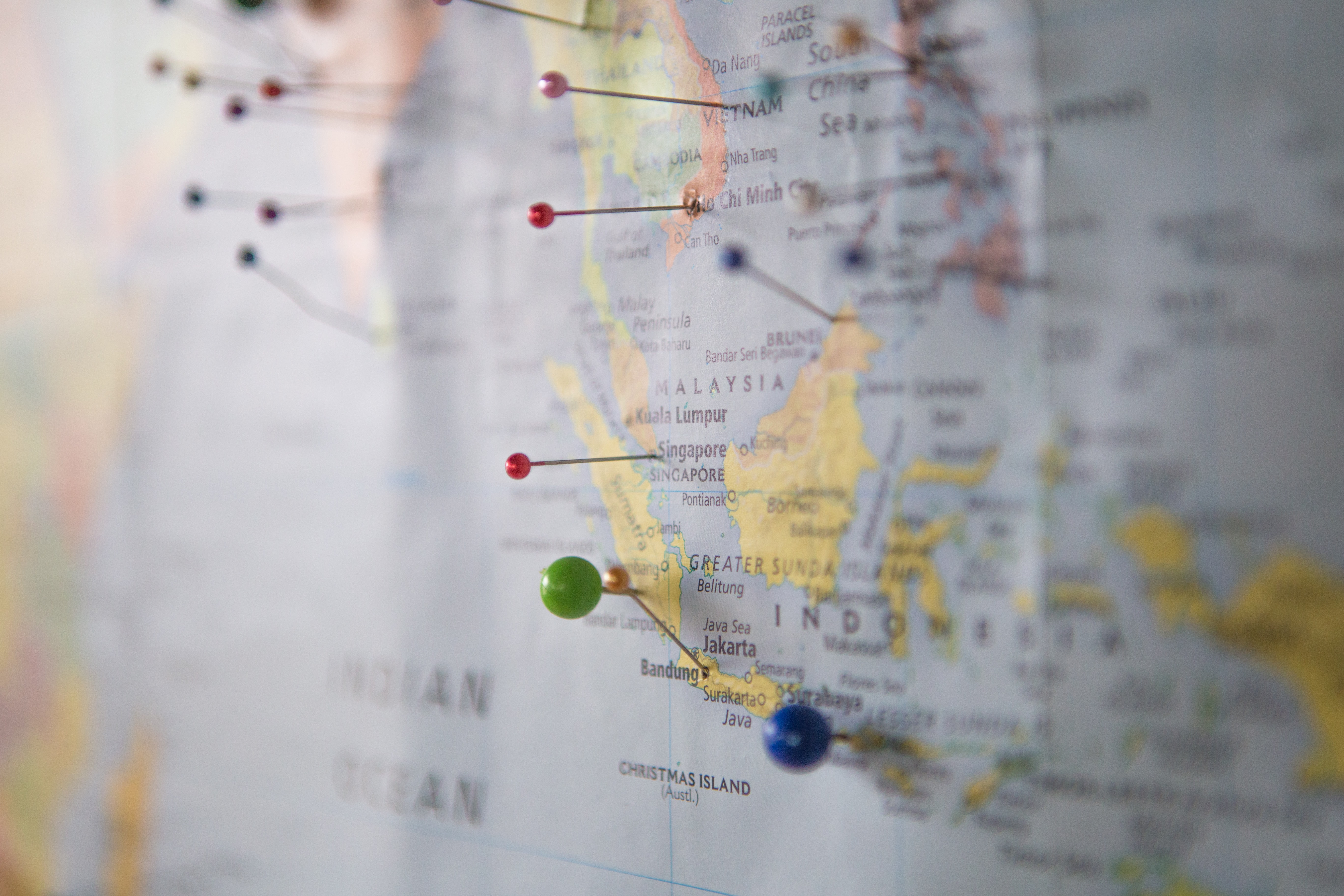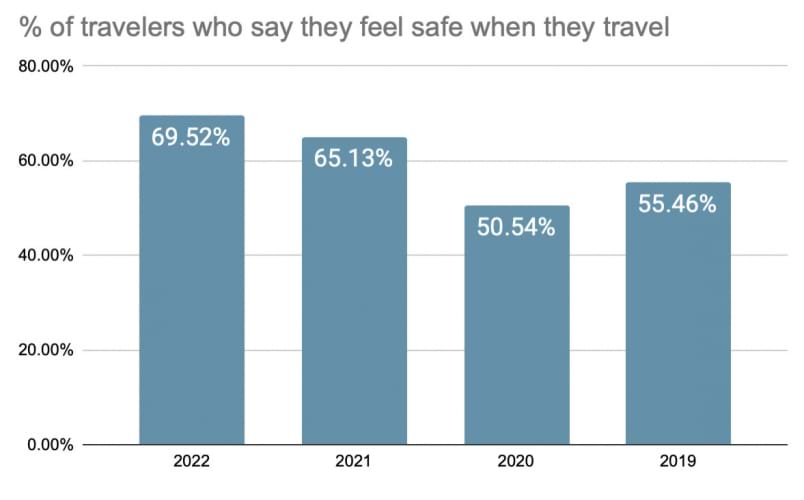 Photo by Z on Unsplash
Photo by Z on UnsplashTRAVEL SAFETY IN 2022: THE SAFEST PLACES TO GO (AND BEYOND)
Note: This post originally appeared on the GeoSure Global website. It appears here with the permission of GeoSure Global.
The last two-plus years have brought a lot of changes to travel, and that’s an understatement. Basically anything anyone ever knew or assumed about travel has been turned on its head by a pandemic and subsequent global upheaval.
Travel safety has arguably been battered the most by this tidal wave of upheaval. What people considered to be a safe trip just three years ago is nothing like what they consider to be a safe trip today.
No one knows this better than the travel insurance provider Berkshire Hathaway Travel Protection. For the last five years BHTP has conducted research into travelers’ attitudes toward travel insurance, travel safety, and what really makes a destination safe.
Here are some of the things BHTP has found about travel safety, and how people’s concepts of travel safety have changed – not only over the years, but from traveler group to traveler group.

FINDING #1: PEOPLE FEEL SAFER THAN EVER WHEN THEY TRAVEL
Despite everything from terrorism to pandemics, more than two-thirds of travelers say they feel safe when they travel. The question has been asked every year for the last four years, and the percentage of travelers who say they feel safe just keeps increasing.
This is especially remarkable when you realize that the number of travelers who say they feel safe when they travel increased from half to almost two-thirds in the middle of a pandemic.
What’s driving this feeling of safety and security among travelers, even in the face of some real dire stuff?
In a word: Millennials.
Millennial travelers are much more likely to say they feel safe when they travel, with around three-quarters of them saying they feel safe:

Of course, if Millennial travelers are more likely to say they feel safe when they travel, that means some group is feeling less safe, and that group would be older travelers.
Millennial travelers and older travelers reacted to the pandemic in vastly different ways. Older travelers told BHTP they largely stopped traveling overseas and restricted their travels to road trips and family vacations.
Millennials, on the other hand, said that they continued to travel internationally, or planned to continue to travel internationally, taking different types of transportation and visiting different destinations as opposed to not traveling altogether.
 Photo by Wang Xi on Unsplash
Photo by Wang Xi on Unsplash
FINDING #2: MONEY TALKS
The pandemic really exacerbated a shift in the profile of the average traveler and a split in attitudes toward travel among older and younger travelers.
Many of the Baby Boomers who drove travel over the last several decades are cutting back on travel, and younger, more adventurous travelers are taking up the slack.
You can see this by looking at the data on travel spending over the last several years. Younger travelers are saying they’re spending more on travel, and older travelers aren’t:

Over the long term, this is actually a good sign. It shows that a new generation is showing its love for travel in the most tangible way possible – by spending money on travel.
The BHTP data shows this not only in terms of actual spending but potential spending. According to its research, if you gave an older person an extra $5,000, they’d be more likely to save it. Younger people would be much more likely to spend it on travel.
 Photo by Simon English on Unsplash
Photo by Simon English on Unsplash
FINDING #3: THE DECLINE OF TERRORISM … SORT OF
Terrorism might not be on people’s radar to the same extent that it was several years ago, and that’s led to some mixed feelings about its impact on travel safety.
When BHTP first started conducting travel research in 2017, here were the biggest threats to travel, in order of importance, with the percentage of people who see it as a threat in parentheses:
- Problems with airlines/flights (26.11%)
- International terrorism (25.74%)
- Restrictions on loyalty programs (13.7%)
- Disease outbreaks (12.04%)
- Natural disasters (11.66%)
- Computer outages / hacks (11.3%)
- My economic situation (10.56%)
- The 2016 elections (10.56%)
- The worldwide refugee crisis (10.37%)
- The international economy (6.11%)
Here are the biggest threats to travel in 2022:
- Disease outbreaks (55.80%)
- International terrorism (50.74%)
- Travel suppliers going out of business (33.29%)
- Climate change / environmental impacts of travel (34.70%)
- My personal health (34.20%)
- My economic situation (33.92%)
- Vanishing destinations (39.27%)
- Natural disasters (42.22%)
- Safety concerns at my destination (43.70%)
- Increased cost of travel (40.95%)
- Problems with airlines / flights (38.84%)
While terrorist incidents affecting travelers have largely ceased to be a problem, people still seem to see terrorism as twice the travel threat it was five years ago. Why?
One of the interesting byproducts of the pandemic is that it caused huge jumps in the number of people willing to consider anything to be a threat to travel, regardless of whether it had anything to do with the pandemic.
That’s one side of the picture. Here’s the other side.
When travelers were asked in the latest survey to list the factors that make a destination safe, freedom from terrorist attacks only came in middle of the pack, far behind being able to move about freely and safely.
Even though travelers seem to be a little more jumpy than in the past, for many of them, practical concerns trump terrorism when it comes to judging a destination as safe.
THE BOTTOM LINE: THE WORLD’S SAFEST PLACES
For the last four years, BHTP has asked travelers to rate countries on safety, and has used that data as the cornerstone of an overall safety index that also includes data from:
- GeoSure Global, whose GeoSafe ratings evaluate a destination almost on a block-by-block basis on measures ranging from safety for LGBTQ+ travelers to safety at night;
- The Global Peace Index, which measures how militarized a country and its citizens are, and how tolerant it is of internal dissent;
- The U.S. State Department’s numerical safety rankings; and
- Ratings on pandemic penetration and handling from global public-health sites.
Even a scale that uses multiple data points is imperfect; for instance, in 2021 China plummeted in BHTP’s rankings because American travelers blamed the country for starting and spreading the COVID pandemic.
Pandemic aside, China didn’t become significantly less safe in any tangible way from 2020 to 2021; American travelers just thought of it as less safe.
 Photo by Galaad Linosfil on Unsplash
Photo by Galaad Linosfil on Unsplash
THE RESULTS
While travel might have been in upheaval over the last couple of years, American travelers have not wavered much in their assessment of the world’s safest countries.
Iceland has been a top-10 finisher for as long as BHTP has done its index, and it once more took home the top spot in 2022.
Iceland’s win continues a four-year streak in which the country deemed safest is English-speaking and/or part of Europe. These countries also dominate the top 10.
It makes sense. If you think back to what travelers said makes a destination safe – being able to move about freely and safely – these are countries where it’s possible for American travelers to just that.
As for the world’s safest city, a plot twist: It’s a predominantly French-speaking city in a predominantly English-speaking country.
Montreal, which made the list for the first time this year, took home the title of the World’s Safest City, narrowly nudging out Amsterdam for the honor.
Repeat top-10 finishers included London, Tokyo, and Berlin.
Be sure to check out the blog posts for the full top-10 lists of the world’s safest countries and the world’s safest cities.
GENERAL OBSERVATIONS ON SAFE DESTINATIONS
Especially these days, travel safety is in the eyes of the traveler. For instance, Africa was one of the safest places to travel during the pandemic in terms of COVID infection rates, but did African travel spike? It barely budged.
Similarly, London experienced some crippling COVID spikes, but it still remained safe in the eyes of American travelers, who also were willing to turn a blind eye toward issues with destinations like Singapore and Dubai.
Also, what you might consider to be a safe destination might seem unsafe to others, whether because of their gender, their ethnicity, or their tolerance for cultural differences.
However, if you’re a typical American traveler, especially a younger traveler, you’re likely unbothered by anything.
In your case, fire up the motors. It’s time to fly.
Questions About Travel Insurance?
Check out our online guide, "What Is Travel Insurance All About?" We've provided in-depth answers to all your travel insurance questions, starting with the basics.